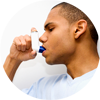Outcomes and Reporting: Measuring Occupational Health Program Effectiveness
In this webinar, you will learn about:
- What is meant by outcomes
- Different ways to measure outcomes
- Best practices for measuring outcomes
Presented by:
Ruth LaRocca, MBA, director of Clinical Analytics for Concentra
Host
0:02
Hello, and welcome to the Concentra® webinar, Outcomes and Reporting: Measuring Occupational Health Program Effectiveness. Today’s webinar will be presented by Ruth LaRocca. Ruth is the director of Clinical Analytics at Concentra. She identifies emergent analytic needs of our employer-clients and oversees the clinical analysts who perform the critical work of producing insights for client-specific outcomes reports. Ruth continues to develop new and innovative methods to measure and report the impact of Concentra’s occupational health products and services.
At the conclusion of the presentation, we will have a 10-to-15 minute Q and A session with Ruth. You can submit your questions throughout the presentation, to be answered during the Q and A. Ruth will answer as many questions as possible within the time allowed. A recording of the webinar will be e-mailed to you after the presentation so you can view it again at your convenience.
Ruth, we're ready to begin
Introduction
1:00
Thank you, Anna, and welcome to everybody. I’m glad you could join today.
Agenda
1:05
Our agenda today is that we’re going to talk about:
- The role of the occupational health provider
- Is your occupational health provider meeting your goals?
- What are outcomes?
- Why do we measure them?
- How do we evaluate outcomes?
- And, finally, I’m going to show you some of the reporting that we produce on a client-specific basis.
The role of an occupational health provider
1:30
These are some of the things your occupational health provider should help you do and what you should expect. They should deliver non-injury services, like drug testing and medical surveillance. They should delivery workplace injury care services. They should help employers meet local, state, and federal workplace safety and health standards and advise on how to develop and sustain a healthy, safe working environment. They should help devise an occupational health strategy, based on the employer’s health and safety challenges and goals.
Achieving the best results from each of these aspects requires two things:
- Clear communication
- Partnership between you and your provider
Clinical informatics allows us to identify, measure, effect, and perpetuate best practices among our internal clinicians and clear communications allows us to demonstrate the values and core competencies for you, our external clients.
Is your occupational health provider helping you meet your goals?
2:32
Is your occupational health provider helping you meet your goals? Where is there evidence of success? If these are the things we just mentioned, what you would expect from your occupational health provider, how do you know if they are helping you meet your workplace or workforce goals? There needs to be a means to measure occupational health program progress, based on your predefined goals. In other words: What are the outcomes?
What are outcomes?
3:00
The Centers for Disease Control and Prevention, or CDC, is a strong advocate of outcomes measurement in occupational health. In fact, the CDC’s workplace health model includes recommendations that mirror the guidance provided in the CDC’s Framework for Program Evaluation in Public Health, where outcomes measurement is a vital part of program evaluation. So we need to measure them so that we can establish that we are actually helping you meet your goals.
Let’s talk about “What are outcomes?” WHO, the World Health Organization, defines outcomes as “The effect the process has had on the people targeted by it.” Other large organizations, like CMS and the Joint Commission that have their own definitions. But don’t get caught in the quagmire of all the definitions and the quantities of measures. They key is, really, to take the definitions and make them work on a series of specific measures that you’re tracking.
If we look at the WHO definition, there are really three separate, but equally powerful things in that statement: process, people, and effect. If you think about that in a non-health care framework, financial results are really outcomes. They’re designed to inform the organization about revenues, expenses, and net income. Process is the method by which those organizations achieve those goals.
What is the product or service? How’s that marketing goal? What’s the price point? Who are the people targeted by the process? Their employees? Their customers? Their shareholders? And what’s the effect of the process? You have sales, returns, customer satisfaction, bonuses or commissions, stock price. The outcomes are measuring the effects of that process on all the people targeted by it.
Another example: Probably one of the most extensive set of outcomes measures exists in sports. The overall outcomes, which are wins, losses, or championships, are supported by an extensive set of intermediary measures. Attempts, misses, assists, interceptions, completions, RBIs, home runs, height, weight, ages of players. You have an enormous amount of sports statistics.
To follow the sports analogy, every organization has a process to achieve the results and that process may encompass many different aspects. You have scouting, training, conditioning, coaching, offense, defense, special teams. The outcomes reflect on how well those processes are working.
Choosing appropriate outcomes measurement should give you insight into where and how to tweak the process if the outcomes aren't what you expect. So, do you need to beef up your offensive line? Do you need a new kicker, or can you work with the kicker you have to gain more accuracy? Do you need a new office coordinator? How can you do better at getting new talent?
When you think about that WHO definition in a health care setting, you can see that the process has an effect on patients, clinicians, front-office staff, employers, and payors, and that measuring the effects of those targeted can be extensive, and it requires planning. The one thing to keep in mind is that while you can talk about the outcome of a case, what we're talking about here, in terms of outcomes, are the outcomes of the process as a whole – so, the effect that the process has on who's targeted. The outcomes are not measured on a transactional or case-by-case level, but rather as a periodic assessment of the program as a whole. Just as you wouldn't measure the corporation's results by one sale or one expense or your favorite sports team’s result by one interception, one touchdown, or one win or loss, your health care programs shouldn't be measured by one case, but rather overall.
Why are outcomes as defined by Concentra?
6:45
So what are outcomes, as defined by Concentra. To reframe outcomes back to health care and the partnership with your occupational health provider, Concentra had been measuring outcomes for more than 20 years. We define outcomes as an empirical, evidence-based system of measuring how claims are being managed through the process and across the injury population over time. We have a very extensive database of cases to refer to with over 700,000 cases annually. As your occupational health partner, we want to share with you how we manage the cases we treat.
While you may have other goals, metrics, and data that we don't have as your provider, but as your provider-partner, we want to share the outcomes and insights for the cases that we treat in our physical and virtual centers. One of the ways we do that is to measure the cases that close during a period and look at the outcomes in terms of four categories of measures:
- Frequency. How many times does something occur on average each day? An example might be the number of medical visits or the number of physical therapy visits.
- Intervals. What time elapses between events? For example, how many days was it to your first physical therapy visit?
- Rate. How often does something occur within the population? For example, what percentage of the population is referred to a specialist or physical therapy?
- Duration. How long does something last? An example of a duration measure we will look at is the disability period or the case duration.
Why do we measure outcomes?
8:20
Now that we've discussed what outcomes are, we can look at why we measure them. We broadly said earlier that choosing appropriate outcomes measurement should give you insight into where and how to tweak the process, if the outcomes aren't what you expect, or desire. So, if you look at this chart, the top line really represents overall program goals that I think everybody can agree on:
- Promote work injury prevention
- Reduce direct and indirect costs of work injuries
- Monitor and improve outcomes in the changing work populations
- Promote acceptance and implementation of best practices
- Monitor and improve employee (patient) satisfaction
Those are broad, overall goals. The second line of icons are really the measurements or benchmarks:
- Assess current status to know where we are (internal or external benchmarking)
- Monitor trends
- Identify variations in care
- Identify areas where interventions could improve care
- Provide evidence about the effectiveness of intervention programs
Are we already on top of our game, or do we have areas where we can improve? Where can we reduce direct and indirect costs? How can we improve employee (patient) satisfaction? We need to know where we are in order to determine those things. We want to monitor trends to ensure that we're moving in the right direction and to catch any negative trends early, so we can implement interventions. We want to identify variations in care, which is not to say that every case should be treated exactly the same. Variations in care may be entirely valid due to local regulation. Differences in populations or other factors. But we want to identify and understand the differences or they may signify a shift. Maybe the injury population has changed. Maybe they're seasonal workers. Maybe there was a new acquisition or line of business. Maybe it's a shift due to external forces, like a regulation or a pandemic. We want to identify areas where interventions can improve care. If there are trends suggesting external influences such as a pandemic or new regulation, or if there are changes in the workforce population such as with seasonal workers, how can we address those areas? We want to be able to pinpoint those trends and work to address them. We want to provide evidence about the effectiveness of the intervention program. If we implement an intervention, we want to measure and track that intervention to ensure it's having the intended effect. If it's not, we want to refine that intervention or possibly implement a different one.
So, in summary, why do we want to measure outcomes? We want to view how our programs and interventions are functioning, and where we might direct our attention.
We've defined what outcomes are, and we've talked about why we want to measure them. But measurements on their own don't necessarily help. If we see, for example, that our case duration is X, what does that really mean? You have to evaluate that measurement in order to understand it.
How do you evaluate outcomes?
How to evaluate outcomes
11:13
One way to evaluate outcomes is to compare to the industry as a whole or to a peer group. We said earlier that it's important to know where we currently stand. Comparing ourselves to a peer group is a good way to do that. It gives us context. Another way to look to year over year or compare period-over-period comparisons. Are we getting better? Are getting worse? Are we staying the same. We can also compare against subpopulation, market, state, or in their industry. You can compare to others in your same industry or same geography. That also provides context. Again, once we evaluate the outcomes and see how we compare, we can implement targeted improvement programs.
If we haven't done the evaluation, we may not know where to target the improvement initiatives, but by doing them, we can gauge where to intervene. Lastly, we need to monitor and assess the results on an ongoing basis so we can continue to improve. Also, by monitoring on a regular basis, conditions do change. We can be on the front end of those changes with the ability to respond quickly.
So, we've talked through what outcomes are, how to measure and evaluate outcomes, and started to see that it's really a process. When you evaluate the outcomes, you want to identify the most beneficial areas for improvement. What’s going to get you the biggest bang for your buck? What's the highest priority?
If you see a trend that affects one percent of the population and another trend that affects 20 percent of the population, it may be more beneficial to target the latter area.
Next, you need to plan your improvement program. What will it consist of? Will it be an awareness program? Does it require training or system changes? Is there a review process? After you've planned and developed the improvement program, how will you implement it? What's the communication plan? Is there training involved? How will you enforce it? Are you going to need to do audits of the program? Once the program is implemented, then the cycle really starts over. You will monitor and assess the results of both the overall outcomes and the effects of the new intervention. Is it having the desired effect? Does it affect other areas or your program that were not intended? Do any changes need to be made?
13:32
The CDC’s effective program evaluation systematically examines the implementation and the results of strategies and interventions with the aim of using findings to improve those actions. As such, it's important that the evaluation approach be useful, feasible, ethical, and accurate. The CDC outlines a series of five steps to help ensure program evaluation, which includes outcomes measurement to meet the criteria and provide results that will be high-value in program implementation and improvement.
Step 1. Engage your stakeholders. Who are your stakeholders that the occupational health program will benefit? Who are the stakeholders who will make decisions about the occupational health program’s value, continuation, and funding? Have conversations with these stakeholders and use the feedback to determine the most important parts of the program to include in the evaluation of the program.
Step 2. Describe the program. Commit to the key elements of your occupational health and safety program in writing. Make sure to document the aspects most important to key stakeholders and decision makers, based on the feedback you got from them. Decide on the benchmarks whose achievements will make the program success, making sure those aspects align with the areas your decision makers believe are most important in an occupational health program.
Step 3. Create the program evaluation design. The CDC identifies three types of measures that are fundamental to program evaluation. They are:
- Baseline measures, which we talked about. We need to know where we are. Baseline measures are the critical measures to be taken at the start of the program and where more positive or negative changes will be measured over time.
- Process measures, which can help you determine if you've taken the wrong approach with your occupational health program or the right approach with a faulty implementation. Process measures can also assess cost of operating programs and the number of employees reached.
- Outcomes measures, which assess the program's effectiveness in meeting your goals and impact over the short, medium, and long term, including the associated costs. Outcomes of interest depends on your program, but it may include things like program or employee productivity, Improvement of health status, changes in health care utilization, and changes in the workplace health and safety culture.
Step 4. Gather credible evidence. In this case, “evidence” is simply the information that you or your occupational health provider gather about your program's results and impact. Evidence is more credible when it's gathered in a way that's respected by a decision makers, either through your system or an employee survey; for example, when multiple procedures are used for gathering, analyzing, and interpreting data and when participation by employees and other stakeholders is higher.
Step 5. Justify conclusions. Measuring an array of outcomes and amassing information about program results is not your “end game.” Measuring is not the last thing. You need to evaluate them. The evaluation must lead to conclusions that are tied to the evidence, and developed through analysis and synthesis (to identify patterns and trends), interpretation (to uncover what findings mean), judgments (statements about the worth of the program or individual aspects) and recommendations (the actions that should become the next logical step after the evaluation).
Step 6. The findings of your program evaluation won't become reality or lead to program improvements without focused and strategic follow-up. Knowledge has to be translated into action and that begins with communication to the relevant audiences in an atmosphere of trust.
Appendix: Concentra Compass Report
17:26
The appendix I'm going to show you is an example of what we do. Here are Concentra, as your occupational health care partner, we want to share with you the outcomes we measure and show you how we manage your cases. As part of that, we produce a comprehensive customer-specific quarterly outcomes report, which we call the Compass Report to summarize the care your employees received in our clinics. This report includes comparisons of year-over-year results. We also produce the same reporting for industry, states, and markets that can be used for comparison. We also provide reporting by channel in clinic, telemedicine, and on-site clinics. From this reporting, your Concentra account team can work with you to provide actionable insight on injury frequency, utilization, duration, and cost.
There are seven pages or topics or chapters that walk you through the outcomes of the cases in the reporting period. Pictured here is the Workers' Compensation Program Summary, which is the first chapter, and it gives you a one-page executive overview of your cases and outcomes. And you'll also see, on the right-hand side, a new site section, which explains why we're including these metrics, why it's important, how to interpret it, and, in certain areas, comparisons to industry standards.
The other chapters are listed there: injury case profile, medical referrals and visit utilization, physical therapy referrals and therapy utilization, return-to-work management, disability to duration, and primary care duration and charge profile.
On the next slide, you'll see some examples of what this looks like. Each of these pages gives you a glimpse into the reporting by chapter or topic. The injury profile chapter provides you a breakdown of injuries with a year-over-year comparison and a breakdown of cases by gender. Medical referrals and visit utilization show you the utilization rate, along with any prescription utilizations, physical therapy, referrals, and therapy utilization show you the physical therapy utilization rate.
Looking at the last three pages, the first two of these chapters give you insights into the return-to-work management and disability duration. And the last chapter wraps it all up with the primary care duration and charge profile and allows you to assess the overall duration of the cases closed in the period.
That is what we provide and your team can just show you how we manage your cases and where we can draw insights and help you to improve your program.
20:09
That is the end of my presentation, so, if anyone has questions, I will turn it over to you.





